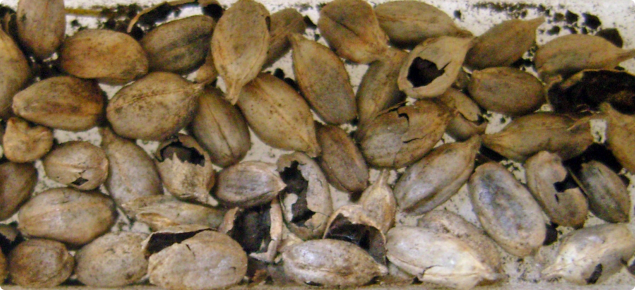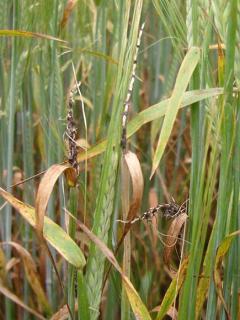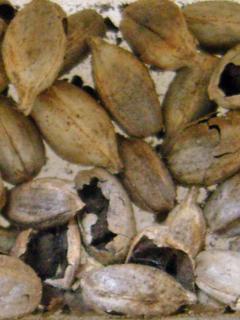The major Western Australian cereal crops, wheat, barley and oats, are susceptible to a range of smut and bunt diseases. Generally, smut diseases are host specific, meaning that smut of one cereal crop will not infect others (for example, loose smut of wheat does not infect barley or oats). Smut diseases have one of two distinct life cycles: internally seed-borne or externally seed-borne. It is important to know the type of smut and its life cycle in order to determine effective control options.
Internally seed-borne smut diseases
Loose smut of barley and wheat are internally seed-borne and carried as a small colony of fungus inside the seed embryo rather than as spores on the seed coat. These are the only internally seed-borne smuts that occur in Australian cereal crops. Contaminated machinery and soil do not transmit these diseases.
Loose smut of wheat and barley
Loose smut of barley (Ustilago nuda) and wheat (Ustilago tritici) are caused by different fungal species specific to the crop they infect, however they have similar life cycles. Infected seed shows no symptoms and appears normal. When infected seed germinates, the fungus becomes active and grows slowly in the growing point of the plant. Diseased plants appear to grow normally but may be slightly taller and earlier maturing than surrounding healthy plants. At heading, the fungus forms a compact spore mass to replace all florets within the cereal head (Figure 1).
All tillers on an infected plant can produce smutted heads and infected plants produce little or no grain. The black powdery spores blow away to leave a bare stalk or rachis (Figure 2). The spores are released as the rest of the crop is flowering. They infect the developing grains of healthy plants and remain dormant until sown the next season. Frequent rain showers and high humidity at flowering favour infection. The higher rainfall southern areas of Western Australia are traditionally the worst areas for loose smut of wheat and barley. Further information is available on the my crop pages: Diagnosing loose smut in wheat and Diagnosing loose smut in barley.
Trials in 2014 and 2015 showed that Hindmarsh is the variety most susceptible to loose smut while La Trobe and Granger are moderately more likely to be affected by loose smut than the varieties Bass, Flinders, Gairdner and Scope CL. Seed of Hindmarsh, La Trobe and Granger should be treated with the seed dressings which provide best control.
Yield loss is directly related to the level of infection in sown seed. Grain receival points accept small quantities of loose smut contamination in wheat and barley before applying dockages.
How to avoid or manage it
The disease is controlled by pickling seed with a systemic fungicide which penetrates the developing seedling to kill the internal infection. Cereal seed dressing fungicides differ in their efficacy for smut management with trial research demonstrating that some seed dressings can reduce the incidence of loose smut in heavily infected seed to nearly zero. The correct application of seed dressings is critical to ensuring adequate control. In-furrow and foliar fungicide applications are not effective. The factsheet - Controlling loose smut of barley, which compares seed dressings, is available from this page.
Externally seed-borne smut diseases
For the majority of smut diseases (except loose smut of wheat and barley), spores are carried externally on the seed surface, found as contaminants in machinery, or fall to the ground during harvest and remain in the soil. Externally seed borne smut diseases include common bunt and flag smut of wheat, covered smut of barley and covered smut and loose smut of oats. During harvest the smutted parts of the cereal plant are broken apart spreading smut spores and contaminating healthy seed, machinery and soil. Seed and soil borne spores remain dormant over summer and germinate in the following season under cool moist conditions, infecting the seedling before emergence. The fungus grows within the plant, eventually forming smutted heads or leaves (in the case of flag smut). Infected seed is the primary inoculum source of externally seed-borne smuts. The soil-borne phase is a particularly important source of infection in flag smut and may be important for common bunt of wheat.
Common bunt of wheat (stinking bunt, stinking smut, ball smut)
In wheat plants infected with bunt (Tilletia laevis and Tilletia caries), the fungus replaces the inside of the developing seed with a mass of stinking bunt spores. Infected plants are difficult to identify prior to harvest but may be slightly stunted. At maturity, infected heads may be darker coloured with the glumes containing the ‘bunt balls’ spread apart more than on healthy heads (Figure 3). Infected kernels are greyish-brown (Figure 4). When the fragile seed coat is crushed or broken, the soot-like spore mass with its characteristic stinking fishy odour is revealed. Bunt spores can survive in soil for at least one year and on seed for several years. Further information is available on the my crop page: Diagnosing common bunt of wheat.
Bunt is relatively uncommon in Western Australia due to the widespread use of seed dressing fungicides.
Yield losses from this disease are usually minimal and are proportional to the level of infected plants. The greatest impact of this disease is on grain quality, particularly the colour and odour associated with bunt spores. There is nil tolerance of bunt contamination in all grades of wheat at grain receival points. Contaminated grain is not toxic and can be safely fed to stock. However, the strong odour from bunt may cause feed refusal and feeding bunted grain may contaminate previously disease free areas.
How to avoid or manage it
If bunt infection does occur, seed from the affected crop should not be re-sown and machinery that handled contaminated grain should be thoroughly cleaned. Soil-borne inoculum will diminish over time but contaminated paddocks should preferably not be sown to wheat for at least one year. Other crops can be grown as a disease break crop because wheat is the only host of this disease. In the break crop year, any wheat regrowth should be destroyed before it reaches maturity to prevent carryover of infection. Subsequent wheat crops in the affected paddocks and adjoining paddocks should be sown with fungicide protected seed. Some variety resistance is available. Disease rating information for varieties is available in the Crop Sowing Guide.
Flag smut of wheat
Flag smut of wheat (Urocystis tritici) differs from other cereal smut diseases by exhibiting symptoms in the leaves rather than the heads. Affected plants are often stunted and infected leaves may be curled and distorted. Initially, the spore masses are invisible under the leaf surface, but between stem elongation and heading, they break through the surface as distinct, long, raised streaks of sooty spores on leaves and leaf sheaths (Figure 5).
Infected plants can tiller excessively but symptoms do not always occur on all tillers. Affected tillers do not usually produce grain. Spores of this fungus are carried on seed and in soil, the spores can survive in soil up to seven years. Further information is available on the my crop page: Diagnosing flag smut of wheat.
How to avoid or manage it
Resistant varieties are available and can be utilised in known affected paddocks. This disease is well-managed by fungicide seed dressing and occurs only sporadically, usually following successive plantings of untreated susceptible varieties. In paddocks contaminated with flag smut, use clean fungicide-treated seed of resistant varieties to reduce disease risk. Disease rating information for varieties is available in the Crop Sowing Guide.
Covered smut of barley
Many of the symptoms of covered smut of barley (Ustilago hordei) are similar to common bunt in wheat. Externally seed-borne or soil-borne spores germinate and infect the seedling prior to emergence. Infected heads may emerge slightly later than healthy heads and become trapped in the boot and emerge from the leaf sheath below the flag leaf. All of the grains in an infected head are replaced by brown-black masses of spores (Figure 6). Further information is available on the MyCrop page Diagnosing covered smut in barley.
The smut masses do not break up readily or blow away as happens with loose smut. The smut spores are released during harvest and contaminate clean seed, machinery and soil. The presence of barley smut may downgrade quality or exclude barley from delivery.
How to avoid or manage it
This disease is well-managed by regular application of fungicide seed dressing. Contaminated seed is the primary disease source and should not be re-sown. Resistant varieties are available. Variety information is available in the Crop Sowing Guide.
Loose and covered smut of oats
Loose smut (Ustilago avenae) and covered smut (Ustilago hordei) of oats are both externally seed-borne diseases with similar symptoms which are difficult to distinguish in the field. Both diseases are managed in the same way.After sowing, spores on the seed surface germinate and infect the emerging seedling. The fungus grows without symptoms within the plant and identification of infected plants is difficult prior to head emergence. Affected plants may be slightly taller and heads emerge earlier than the main part of the crop. Each spikelet, including the chaff, is transformed into a spore mass which is at first covered with a fine membrane. This membrane soon bursts releasing the spores to contaminate healthy heads, leaving a bare stalk or rachis on the infected plant.
How to avoid or manage it
These diseases are well-managed by regular application of fungicide seed dressing and replacement of contaminated seed stocks.
Karnal bunt of wheat
Karnal bunt of wheat (Tilletia indica) does not occur in Australia but is found in many other wheat producing countries. Karnal bunt is also referred to as ‘partial bunt’ because it infects only some grains within a head and infected grains may be only partially bunted (at the embryo end). Contaminated grain has a strong fishy odour. Spores are dispersed from bunted heads at harvest to contaminate healthy grains, soil or machinery.
This disease has a minor effect on grain yield but significantly affects grain quality because of its distinctive fishy odour and discolouration. An outbreak of this disease would have major impacts on export wheat markets available to Australian wheat. Karnal bunt is externally seed-borne and could enter Australia as spores contaminating grain, machinery or clothing. Minimising the possibility of Karnal bunt spores entering Australia is very important to the Australian grains industry. More information on Karnal bunt of wheat is available in the Plant Health Australia factsheet on the right under 'External links'. Suspect samples should be reported immediately to the Department of Agriculture and Food, Western Australia on the Exotic Plant Pest Hotline on 1800 084 881.
Disease diagnosis and control
Contact DAFWA Diagnositic Laboratory Services for assistance with disease identification in seed and plants. This is a chargeable service. Telephone 08 9368 3721.
Registered fungicides
For information on managing cereal smut and bunt diseases with fungicides at seeding (seed dressings) see the Seed dressing and in-furrow fungicides for cereals in WA page.
Variety disease ratings
For information on managing cereal smut and bunt diseases with variety resistance see the Crop Sowing Guide.



